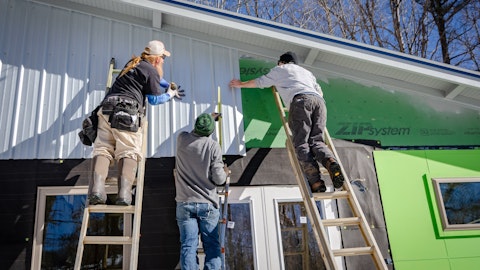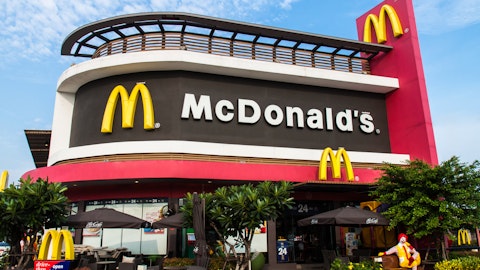Cavco Industries, Inc. (NASDAQ:CVCO) Q3 2024 Earnings Call Transcript February 2, 2024
Cavco Industries, Inc. isn’t one of the 30 most popular stocks among hedge funds at the end of the third quarter (see the details here).
Operator: Good day, and thank you for standing by. Welcome to the Third Quarter Fiscal Year 2024 Cavco Industries, Inc. Earnings Call Webcast. At this time, all participants are in a listen-only mode. After the speakers’ presentation there will be a question-and-answer session. [Operator Instructions] Please be advised that today’s conference is being recorded. I would now like to hand the conference over to your speaker, Mark Fusler, Corporate Controller and Investor Relations. Please go ahead.
Mark Fusler : Good day, and thank you for joining us for Cavco Industries third quarter fiscal year 2024 earnings conference call. During this call, you’ll be hearing from Bill Boor, President and Chief Executive Officer; Allison Aden, Executive Vice President and Chief Financial Officer; and Paul Bigbee, Chief Accounting Officer. Before we begin, we’d like to remind you that the comments made during this conference call by management may contain forward-looking statements including statements of expectations or assumptions about Cavco’s financial and operational performance, revenues, earnings per share, cash flow or use, cost savings, operational efficiencies, current or future volatility in the credit markets or future market conditions.
All forward-looking statements involve risks and uncertainties, which could affect Cavco’s actual results and could cause its actual results to differ materially from those expressed in any forward-looking statements made by or on behalf of Cavco. I encourage you to review Cavco’s filings with the Securities and Exchange Commission including, without limitation, the company’s most recent Forms 10-K and 10-Q, which identify specific factors that may cause actual results or events to differ materially from those described in any forward-looking statements. This conference call also contains time-sensitive information that is accurate only as of the date of this live broadcast, Friday, February 2, 2024. Cavco undertakes no obligation to revise or update any forward-looking statement, whether written or oral, to reflect events or circumstances after the date of this conference call, except as required by law.
Now I’d like to turn the call over to Bill Boor, President and Chief Executive Officer. Bill?
Bill Boor : Welcome, and thank you for joining us today to review our third quarter results. While the earnings release focuses on year-over-year comparisons in this market, I believe the quarter-to-quarter developments are more relevant to understanding current market dynamics. It’s not to disregard any insights and bigger picture takeaways regarding the dynamics a year ago relative to today. Last year, we were a couple of quarters into the effect of rising interest rates, industry backlogs were higher than now, but they were declining rapidly and the pace and direction of backlogs is generally more important than the level. As we wrapped up this third quarter, rates [Indiscernible]. In fact, on a same plant basis, we have now seen five quarters of increasing net orders and backlogs are stabilized, albeit at low capacity utilization.
So while economic uncertainty remains, the trends are pointed in the right direction as we emerge from the typically slower winter and holiday months. The positive trending we’re seeing in the market is coming from the dealer channel. Their traffic remains healthy and conversions are improving. Buyers are adjusting to the now steadier interest rates and to the reality of how much home they can afford. The underlying need for affordable housing is coming to the forefront and driving modest but meaningful quarter-to-quarter order improvements. As discussed over the past few quarters, community orders continue to be off considerably. As industry backlogs decreased in the latter part of 2022, deliveries to communities accelerated, which resulted in excess community inventories going into calendar 2023.
The issue is not whether there are buyers or renters once a given unit is put into service. It’s how quickly the units can be permitted and set to reduce the inventory and resume more normal orders. In other words, placements are occurring at a much higher pace than orders until balances reestablished. The natural question is, when will this balance be achieved? Of course, varies by operator and location. However, the outlook for this calendar year is considerably better than last based on our discussions with community operators and developers. We expect we will see increased community orders as the year unfolds. Against that market backdrop, we’ve stabilized our backlog over the past three quarters by matching production to the pace of orders.
Our capacity utilization remained steady this quarter at about 60%. And while the value of orders in the backlog declined from $170 million last quarter to $160 million in Q3, the number of units in the backlog increased 3%. The quarter ending backlog represents five to seven weeks of production, consistent with last quarter. That stability is an important point coming through the winter months and heading into what we typically would expect to be better selling months. We have a number of plants operating at reduced schedules that are looking to increase when the market supports. On the margin side, pricing has been relatively stable. While our overall factory-based housing gross margin declined 0.8% sequentially, this was driven more by the cost side and how cost of goods sold flowed through our manufacturing and retail sales.
Big picture margins remained healthy at 22.4% in our housing segment, and prices are continuing to hold for the most part. Overall, our quarterly revenue was down about 1% sequentially to $447 million and pretax income dropped from $52 million last quarter to $44 million. Before repurchases and after acquisitions, cash flow was about positive $25 million. We used $50 million to repurchase shares, which resulted in our cash balance being down $24 million relative to last quarter. Before handing the call over, it was good to see many of you at the Louisville show a couple of weeks ago, among a number of other innovative homes, we brought our new Anthem series Duplex to Louisville. The Anthem is the first nationally available HUD-approved multifamily unit.
We’re very excited about the affordability benefits these homes offer and the interest level has been tremendous, particularly with developers and community operators. I also wanted to recognize and welcome Dustin Ying and the people from Kentucky Dream homes to the Cavco family. Kentucky Dream Homes operates five well-managed sales centers in Kentucky and Florida, and we joined forces through an acquisition in the third quarter. Dustin and his team are strong operators and great people to be associated with, and we’re very excited to be on the same team. With that, I’d like to turn it over to Allison to discuss the financial results in more detail.

Allison Aden : Thank you, Bill. Net revenue for the third fiscal quarter of 2024 was $446.8 million down $53.8 million or 10.8% compared to $500.6 million during the prior year. Sequentially, net revenues decreased $5.3 million driven by a reduction in units sold, partially offset by higher revenues in financial services. Within the factory-built housing segment, net revenue was $427 million, down $54.2 million or 11.3% from $481.2 million in the prior year quarter. The decrease was primarily due to a 13.7% decline in base business unit volume and a 5.3% decline in average revenue per home sold, partially offset by the Solitaire acquisition, which contributed $33 million during the quarter. The decrease in average revenue per home was primarily due to more single wise in the mix and to a lesser extent, a decline in product pricing.
Sequentially, for the factory-built housing segment, net revenue was down $7.1 million or 1.6% from $434.1 million. The decrease was primarily due to a 2.1% decline in units sold partially offset by higher average revenue per home, primarily due to more double-wise in the mix and a higher proportion of homes sold through our company-owned stores. Back to utilization for Q3 of 2024 was approximately 60% when considering all available production days, but with nearly 70%, excluding scheduled downtime for market or weather. This utilization level was consistent with the past three quarters. Financial Services segment net revenue increased 2.1% to $19.8 million from $19.4 million, primarily due to more insurance policies in-force, partially offset by fewer loan sales.
Consolidated profit in the third fiscal quarter as a percentage of net revenue was 23.1%, down 330 basis points from 26.4% in the same period last year. In the factory-built housing segment, the gross margin decreased 310 basis points to 22.4% in Q3 of 2024 versus 25.5% in Q3 of 2023, driven by lower average selling prices and volumes partially offset by lower input cost per floor. Comparing to the sequential fiscal Q2 of 2024, while average selling prices increased due to a higher proportion of homes sold through company-owned retail stores, cost per unit sold also increased with the net effect being an 80-basis point reduction in factory built housing gross margin. Gross margin as a percentage of revenue in financial services decreased to 36.8% in Q3 of 2024 from 46.6% in Q3 of 2023 from higher insurance claim activity.
Financial Services gross margin increased sequentially 90 basis points to 36.8% from 35.9% due to higher net insurance premiums earned. Selling, general and administrative expenses in Q3 of 2024 were $63.3 million or 14.2% of net revenue compared to $58.9 million or 11.8% of net revenue during the same quarter last year. Sequentially, SG&A increased $1.8 million. The increase in both periods is primarily due to higher costs in Q3 of 2024 related to the ongoing litigation between an indemnified former officer of the — in the SEC, as well as higher compensation expense from acquisitions. Interest income for the third quarter was $5.2 million, up 46.2% from the prior year quarter and down 9.9% over the sequential quarter. The increase over the prior year is primarily due to higher interest rates, whereas the sequential decrease is related to a lower average cash balance over the period.
Interest expense this quarter was $0.8 million compared to $0.2 million in the prior year quarter. This interest relates to adjustments of our redeemable non-controllable interest in Craftsman Home LLC. Net other expense this quarter was $0.2 million compared to $0.3 million in the prior year quarter. Pretax profit for Q3 2024 was $43.9 million down $32.2 million from the prior year period. The effective income tax rate was 18% for the third fiscal quarter, compared to 21.7% in the same period last year. The change between periods is primarily the result of higher benefits from stock option exercises. Net income attributable to Cavco shareholders was $36 million compared to net income of $59.5 million in the same quarter of the prior year and diluted earnings per share in Q3 of 2024 was $4.27 per share versus $6.66 per share in last year’s third quarter.
Before we discuss the balance sheet, I’d like to take a minute to talk further about capital allocation. As announced with our press release, the company’s board of directors approved a new $100 million stock repurchase program. It can be used to purchase its outstanding common stock. This increases the total available to $139 million including the amount remaining under the program announced in 2023 after our purchase of $50 million this quarter. Our strategic capital allocation priorities remain an improvement further acquisitions and ongoing evaluation of the opportunities in their lending operations. We continue to use stock buybacks as a tool to responsibly manage our balance sheet. Now I’ll turn it over to Paul to discuss the balance sheet.
Paul Bigbee : Thanks, Allison. So I’m going to cover the changes in the December 30, 2023 balance sheet from April 1, 2023. Our cash balance was $352.8 million, up $81.4 million or 30% from $271.4 million at the end of the prior fiscal year. The increases are primarily due to net income adjusted for non-cash items, such as depreciation and stock compensation expense and working capital adjustments, including the following: inventory decreases, which provided $51.2 million from lower balances of raw materials in our production facilities and finished goods at our retail locations. Decrease in accounts receivable of $18.2 million. Prepaid and other asset decreases provided $9.9 million. Primary uses of cash for the nine months, offsetting the above include decreases in accounts payable, accrued expenses and other liabilities of approximately $23 million.
Our acquisition of five retail stores and associated inventory for $19.7 million and share repurchases for $96.8 million. Outside of cash, consumer and commercial loans decreased from the pay down of associated loans that were greater than the amount of new loan originations. Prepaid and other assets was lower due to lower prepaid income taxes and a reduction in delinquent Ginnie Mae loans. The remaining change is due to normal amortization of prepaid. Property, plant and equipment net is down from the sale of unutilized equipment acquired with Solitaire Home. Accrued expenses and other current liabilities are down from lower accrued bonuses, customer deposits and commission taxes. Lastly, stockholders’ equity exceeded $1 billion, up $32.4 million from $976.3 million as of April 1, 2023.
Now I’ll turn it back to Bill.
Bill Boor : Thanks, Paul. So, why don’t we just go ahead and turn it over for questions.
Operator: Certainly. [Operator Instructions] One moment for our first question, which will come from Daniel Moore of CJS Securities. Your line is open.
See also 35 Smartest Countries with the Highest IQ in the World and 10 Stocks Receiving a Massive Vote of Approval From Wall Street Analysts.
Q&A Session
Follow Cavco Industries Inc. (NASDAQ:CVCO)
Follow Cavco Industries Inc. (NASDAQ:CVCO)
Daniel Moore : Good morning, Bill, Allison, Paul. Good afternoon, I should East Coast. But thanks for the time and taking the questions. Maybe start with your kind of outlook. What are your expectations for sequential growth in production and shipments in terms of both modules as well as the number of homes as we look to the March quarter relative to December and similar question, what are your expectations for average selling price?
Bill Boor : Dan. Well, you know we don’t give guidance. And I guess every time we get asked that question, I always feel like we’re at a point, it always feels like we’re in a point where if you go one way or the other, right? I think you probably took from some of my comments that the general feeling is pretty positive going into the spring. That’s mostly coming from just how well the dealer channel is going. And so we feel like we’re in a position to respond to the upside. And that’s where most of our energies are at this point is getting ready for that upside, but we don’t have a specific expectation to share at this point.
Daniel Moore : Understood. I guess what would it maybe talk about, when you would expect to have a better sense of the true underlying demand. Right now, it’s been improving sequentially and certainly strong from a seasonal perspective. But by April, May, when do you have a better sense for whether you might be in a position to start to ramp production?
Bill Boor : Yeah, absolutely. We’re sitting here beginning of February, always making very general statements when we do a market locally as I always remind everyone. But I think internally, we’re kind of looking to late February, March time frame to see an uptick, see the normal selling season and how that develops. And so we kind of in that waiting mode right now coming out of the winter and the holidays. So in the next couple of months, we’ll know whether we saw the meaningful improvement that we’re hoping for in the spring or whether there’s some other issue going on. I feel like as I said in my comments, I think the buyer is there. The interest rates have stabilized. They’re higher than they were a bit ago, and that’s hard for people, but they are kind of acclimating to that.
In some cases, I think we’ve got good indications that they recognize they can’t buy as big a home as they could have bought if they had done so a couple of years ago, but they’re adjusting to all that. So the underlying demand, and I would include as my promise that I would include the communities as well on this. If they can get a home set, they’ve got a renter or a buyer for that home. So we should see some improvement from — we’re hoping we’ll be watching to see some improvement in the selling season. And as the year unfolds, we’re also looking for that community order pattern to start improving.
Daniel Moore : And just based — maybe it’s more anecdotal, Bill, but based on your conversations with some of the community operators, the REITs, where are we if it’s the baseball analogy in that getting through the inventory trouble issues or the set and fitness challenges. I know it’s market by market, but in general, do we have quarters to go, getting to tag ends and waiting on orders? What are you hearing?
Bill Boor : Yeah. This is completely anecdotal and field based on those discussions. And you’ll — I’ll make an analogy. You remember when we were coming out of the retail inventory issue it wasn’t sudden, right? I mean it just kind of happens individually, and it builds up and next thing you know you’re not talking about the problem anymore. So I think it’s going to feel like that. But in our discussions, in my discussions with folks at the larger community operators, they definitely are projecting higher order rates for calendar year ’24 than ’23. So I think in order for that to take place, we should see some improvement in the next couple of quarters.
Daniel Moore : Helpful. Last one, I’ll jump out. Thanks for the color, Allison, as well on the gross margin front and the timing of kind of how COGS are rolling through. At kind of current levels, just speak to your confidence around holding gross margins where we are at these levels? And what kind of potential upside we might have if and when the demand comes back, capacity utilization improves. Thanks, again.
Allison Aden : Yeah. Sure, Dan. Thanks for the question. And just as we said, big picture, the factory-built housing margins remained very healthy at 22.4% this quarter and prices are continuing really to hold for the most part. And while we know based on our prior quarter comments, it’s really hard to speculate on price. I think P&L pricing and cost is going to be the key elements to the determining future margins. And from commenting on the price, we’re seeing some regions where pressure is becoming more apparent and some where it’s not. So it’s a mixed bag. Also, from a cost perspective, we’ve seen the movement in commodities can be a little volatile and hard to predict. So we’re continuing to watch lumber and OSB. As we said last quarter, we believe that we’re doing a good job of really managing our cost of sales. And if we see the top line increase, we certainly have leverage still absorption costing within our cost of goods and also at an SG&A level.
Daniel Moore : Yeah, I’ll come back with any follow ups. Thank you.
Bill Boor : Thanks, Dan.
Operator: And one moment for our next question. Our next question will be coming from Greg Palm of Craig-Hallum Capital Group. Your line is open, Greg.
Danny Eggerichs : Hi, thanks. This is Danny Eggerichs on for Greg today, hoping to just kind of go back and touch on what you’re seeing in fiscal quarter four again. Can you maybe just remind us — I know it’s kind of jumped on in the past of seasonality from December to March quarter? And maybe on top of that, any impacts that you felt from maybe adverse weather in the month of January?
Bill Boor : Let me take that second part first. We did have some pretty isolated down days due to the weather. I know in Texas, we had some in the Northwest. But I think it was to an extent that we’re hoping we can make it up over the course of this quarter, if that makes sense because we are running at a reduced overall rate. And so while we did have some down days, it shouldn’t really knock us off where we would end the quarter otherwise on a production basis, if that makes sense. On the seasonality, I know we’ve looked at that. Mark might have a comment on the percentages. But what I’ll say before we say that is we look at seasonality over a long period of time in many years. And you can kind of glean from that what an average seasonal change will be.



